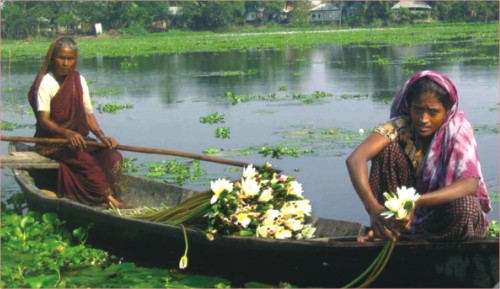| Journy through Bangldesh
From Comilla
Plucking Water Lily
Zakir Azad

On the highway from Dhaka to Comilla after passing Eliotganj, one would see a dirt path taking a curve at a point where there's a signboard for 'Gouripur Bridge'. At the end of the road, was the old bridge, old and in poor condition, on which rickshaws, tempos and pushcarts were plying. After passing the bridge, a little farther ahead, was the Thana Head Quarter and to the east of it was Asmaniya Market. I took the dirt path that went down from the markets side and ended in Ziarkandi village. There was a small water reservoir at the point of entrance to the village. Two boats were drifting slowly here and there on the water. My eyes fell on a middle aged woman swimming swiftly towards the south of the reservoir with splashing sound of water. I asked some people on the bank who the woman was, but no one really cared to know or really bothered to answer. However, as I set up my camera lens to take some photographs, there began a low humming. The woman was plucking water lilies with swift fingers and seemed to be enjoying the work heartily. By this time a boats was fully loaded with flowers. The water Lily plucker climbed on to the boat. Which started moving slowly towards the bank.
The lady who was plucking the lilyes said to her companion, “Suraiya, if your son doesn't come, then we'll put these up on the truck ourselves”. She brought out a rope from the boat and tied it to a tree stump on the bank. Both the women got busy arranging the flowers, tying them in separate neat bundles. When they saw me standing near by with my camera, the woman who was plucking the lilies a while ago asked, “Have you come here to get the news of the tube wells? All the tube wells are under water now.” Then without waiting for an answer she continued, “Do you know what we will do with these? We'll sell these. The truck will come in the afternoon.” Before I could say anything she said, “Will you take a photograph of Suraiya and me? Who knows whether we'll be alive or dead next year? There's no name for this work we do. You tell me why this work should not have a name? Aren't we making money with this? Don't we have any desires and expectations?”
“Yes, sister, your work should definitely have a name. We'll call it 'Plucking water lily'”, I said & sat down beside them. Talking in a friendly way I tried to find out a little more about their work. They said that their men work in various jobs throughout the year but they work only during three months of the monsoon. If there are sudden floods then we're doomed. The roads go under water and communication with other districts is snapped. No work, no food, then.” Then in her characteristic manner which I had noticed earlier, she abruptly changed the topic and said, “How will you send us these photos?” This time I quickly replied, “If one has the heart of a friend, there should be no problem. If you give me your name, I'll send them to you.” Smiling happily she said, “I'm Asia Khatun and this is Suraiya Khatun. Our whole-sale dealer always gets orders for flowers through mails and courier service. Mail comes every day. Just write Asia Khatun on the envelope.”
A few months ago Asia and Suraiya were just house-wives. But now it is a happy time for them. They are busy the whole day doing their household work and then plucking water lilies. The thin faced slim Asia was wearing a new printed sari that she bought with the money she earned selling water lilies. The boat rent had to be paid at the rate of Taka three to four per hour. They earned about one hundred and fifty taka per day, after paying the boat rent. Every bundle of water lily was sold at Taka seven to eight. A bundle consisted of two to two and a half kg. of flowers. Every day three to four trucks loaded with water lily left from the old ferry bank and a minimum of two to two and a half tons of water lilies were dispatched.
Asia, Suraiya, Masuma, Halima and other ten to fifteen women along with their children earn their income working in small marshy lands, ponds, swamps and reservoirs. I looked at Asia and her friend plucking the lilies from water and carrying them handful, they seemed to be some characters out of a fairy tale. No sorrow could daunt their zest for life.
While bidding me farewell, Asia said, “I've been plucking water lilies for the last six years. At present, wives and daughters from neighbouring houses are also associated with this work. Although it is a very short-timed work, we await it with much eagerness and expectation. This area under Comilla district is where the most water lilies grow, but the people here little realise the commercial value of the flowers and their herbs. Water lilies are highly valued in many other districts, especially in Chittagong, Khulna and Sylhet. May be cultivating water lilies would one day turn into an important project and our work will have a name for it. Copyright
(R) thedailystar.net 2006 |
|
